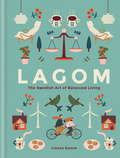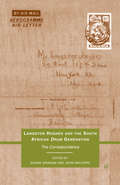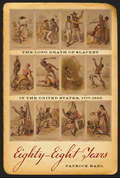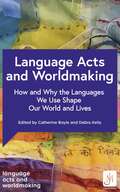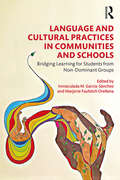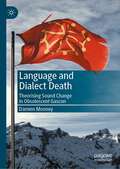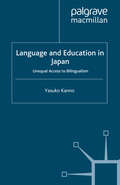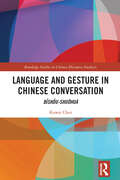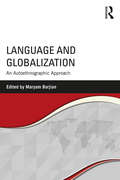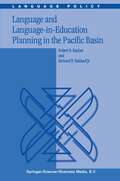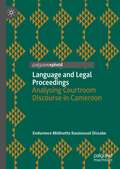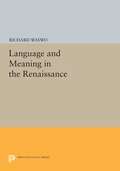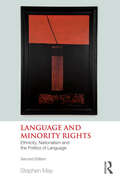- Table View
- List View
Lagom: The Swedish Art of Balanced Living
by Linnea DunneStep aside Hygge. Lagom is the new Scandi lifestyle trend taking the world by storm. This delightfully illustrated book gives you the lowdown on this transformative approach to life and examines how the lagom ethos has helped boost Sweden to the No.10 ranking in 2017's World Happiness Report. Lagom (pronounced 'lah-gom') has no equivalent in the English language but is loosely translated as 'not too little, not too much, just right'. It is widely believed that the word comes from the Viking term 'laget om', for when a mug of mead was passed around a circle and there was just enough for everyone to get a sip. But while the anecdote may hit the nail on the head, the true etymology of the word points to an old form of the word 'lag', which means 'law'.Far from restrictive, lagom is a liberating concept, praising the idea that anything more than 'just enough' is a waste of time. Crucially it also comes with a selflessness and core belief of responsibility and common good. By living lagom you can: Live a happier and more balanced life Reduce your environmental impact Improve your work-life balance Free your home from clutter Enjoy good food the Swedish way Grow your own and learn to forage Cherish the relationships with those you love
Langston Hughes and the South African Drum Generation: The Correspondence
by Shane Graham and John WaltersThis collection combines previously unpublished letters between African-American poet Langston Hughes and South-African writers of the 1950s and 1960s with scholarly commentary and criticism. The letters tell a fascinating story of the civil rights movement and apartheid and the struggle to overthrow it.
Language Acquisition and the Multilingual Ideal: Exploring Japanese Language Learning Motivation
by Toshiyuki NakamuraExamining the motivational development of Japanese language learners, this book investigates the relationship between their future self-image as Japanese speakers and their broader self-image as multilingual individuals. The book compares two groups of Japanese language learners, one from Australia and the other from South Korea. Questioning how motivation is influenced both by native languages and by the other languages which learners speak or study, Toshiyuki Nakamura uses dynamic systems theory (DST) to uncover how knowledge of English in these different contexts motivates the learning of Japanese. Employing the concept of 'domain of possible selves' as an analytical framework, the book also provides a detailed description of the development of the learners' visions of themselves as users of Japanese and uncovers various aspects of Japanese language learners' L2 self.
Language Acquisition and the Multilingual Ideal: Exploring Japanese Language Learning Motivation (Bloomsbury Revelations Ser.)
by Toshiyuki NakamuraExamining the motivational development of Japanese language learners, this book investigates the relationship between their future self-image as Japanese speakers and their broader self-image as multilingual individuals. The book compares two groups of Japanese language learners, one from Australia and the other from South Korea. Questioning how motivation is influenced both by native languages and by the other languages which learners speak or study, Toshiyuki Nakamura uses dynamic systems theory (DST) to uncover how knowledge of English in these different contexts motivates the learning of Japanese. Employing the concept of 'domain of possible selves' as an analytical framework, the book also provides a detailed description of the development of the learners' visions of themselves as users of Japanese and uncovers various aspects of Japanese language learners' L2 self.
Language Acts and Worldmaking: How and Why the Languages We Use Shape Our World and Our Lives
byCollectively authored by the Language Acts and Worldmaking team, this defining volume offers reflective narratives on research, theory and practice over the course of the flagship project of the same name, funded by the Arts and Humanities Research Council's Open World Research Initiative. It returns to the project's key principles - that our words make worlds and we are agents in worldmaking - analyses the practices and outcomes of collaborative working, and looks to the future by offering concrete ideas for how the work they have done can now continue to do its work in the world.Focusing on the key research strands, this volume looks at the role of the language teacher as a mediator between languages and cultures, worldmaking in modern languages, translation and the imagination, languages and hospitality, digital mediations, and how words change and make worlds. Critically, it analyses the impact on communities of living in multilingual cities, and the ways in which learning a first language, and then a second, and so on, plays a crucial role in our ability to understand our culture in relation to others and to appreciate the ways in which they are intertwined.Specific aims are to: · propose new ways of bridging the gaps between those who teach and research languages and those who learn and use them in everyday contexts from the professional to the personal · put research into the hands of wider audiences · share a philosophy, policy and practice of language teaching and learning which turns research into action · provide the research, experience and data to enable informed debates on current issues and attitudes in language learning, teaching and research · share knowledge across and within all levels and experiences of language learning and teaching · showcase exciting new work that derives from different types of community activity and is of practical relevance to its audiences · disseminate new research in languages that engages with diverse communities of language practitioners.
Language and Cultural Practices in Communities and Schools: Bridging Learning for Students from Non-Dominant Groups
by Inmaculada M. García-Sánchez Marjorie Faulstich OrellanaDrawing on sociocultural theories of learning, this book examines how the everyday language practices and cultural funds of knowledge of youth from non-dominant or minoritized groups can be used as centerpoints for classroom learning in ways that help all students both to sustain and expand their cultural and linguistic repertoires while developing skills that are valued in formal schooling. Bringing together a group of ethnographically grounded scholars working in diverse local contexts, this volume identifies how these language practices and cultural funds of knowledge can be used as generative points of continuity and productively expanded on in schools for successful and inclusive learning. Ideal for students and researchers in teaching, learning, language education, literacy, and multicultural education, as well as teachers at all stages of their career, this book contributes to research on culturally and linguistically sustaining practices by offering original teaching methods and a range of ways of connecting cultural competencies to learning across subject matters and disciplines.
Language and Cultural Practices in Communities and Schools: Bridging Learning for Students from Non-Dominant Groups
by Inmaculada M. García-Sánchez Marjorie Faulstich OrellanaDrawing on sociocultural theories of learning, this book examines how the everyday language practices and cultural funds of knowledge of youth from non-dominant or minoritized groups can be used as centerpoints for classroom learning in ways that help all students both to sustain and expand their cultural and linguistic repertoires while developing skills that are valued in formal schooling. Bringing together a group of ethnographically grounded scholars working in diverse local contexts, this volume identifies how these language practices and cultural funds of knowledge can be used as generative points of continuity and productively expanded on in schools for successful and inclusive learning. Ideal for students and researchers in teaching, learning, language education, literacy, and multicultural education, as well as teachers at all stages of their career, this book contributes to research on culturally and linguistically sustaining practices by offering original teaching methods and a range of ways of connecting cultural competencies to learning across subject matters and disciplines.
Language and Culture: Reflective Narratives and the Emergence of Identity (ESL & Applied Linguistics Professional Series)
by David NunanThis state-of-the-art exploration of language, culture, and identity is orchestrated through prominent scholars’ and teachers’ narratives, each weaving together three elements: a personal account based on one or more memorable or critical incidents that occurred in the course of learning or using a second or foreign language; an interpretation of the incidents highlighting their impact in terms of culture, identity, and language; the connections between the experiences and observations of the author and existing literature on language, culture and identity. What makes this book stand out is the way in which authors meld traditional ‘academic’ approaches to inquiry with their own personalized voices. This opens a window on different ways of viewing and doing research in Applied Linguistics and TESOL. What gives the book its power is the compelling nature of the narratives themselves. Telling stories is a fundamental way of representing and making sense of the human condition. These stories unpack, in an accessible but rigorous fashion, complex socio-cultural constructs of culture, identity, the self and other, and reflexivity, and offer a way into these constructs for teachers, teachers in preparation and neophyte researchers. Contributors from around the world give the book broad and international appeal.
Language and Culture: Reflective Narratives and the Emergence of Identity (ESL & Applied Linguistics Professional Series)
by David Nunan Julie ChoiThis state-of-the-art exploration of language, culture, and identity is orchestrated through prominent scholars’ and teachers’ narratives, each weaving together three elements: a personal account based on one or more memorable or critical incidents that occurred in the course of learning or using a second or foreign language; an interpretation of the incidents highlighting their impact in terms of culture, identity, and language; the connections between the experiences and observations of the author and existing literature on language, culture and identity. What makes this book stand out is the way in which authors meld traditional ‘academic’ approaches to inquiry with their own personalized voices. This opens a window on different ways of viewing and doing research in Applied Linguistics and TESOL. What gives the book its power is the compelling nature of the narratives themselves. Telling stories is a fundamental way of representing and making sense of the human condition. These stories unpack, in an accessible but rigorous fashion, complex socio-cultural constructs of culture, identity, the self and other, and reflexivity, and offer a way into these constructs for teachers, teachers in preparation and neophyte researchers. Contributors from around the world give the book broad and international appeal.
Language and Dialect Death: Theorising Sound Change in Obsolescent Gascon
by Damien MooneyThis book offers a systematic acoustic phonetic analysis of both language and dialect death in the region of Béarn, southwestern France. Focusing on Béarnais, a localised dialect of Gascon which is under pressure from French, the author explores the socio-political process of language shift, whereby members of a speech community cease to speak their indigenous language in favour of an incoming dominant language. Gascon is at an advanced stage of this process, making its remaining speakers excellent candidates for the study of language obsolescence, and this unique study will be of interest to researchers working in a broad range of disciplines, including language variation and change, language and dialect contact, Occitan and French, sociophonetics and phonology.
Language and Education in Japan: Unequal Access to Bilingualism (Palgrave Studies in Minority Languages and Communities)
by Y. KannoThe first critical ethnography of bilingual education in Japan. Based on fieldwork at five different schools, this examines the role of schools in the unequal distribution of bilingualism as cultural capital. It argues that schooling gives children unequal access to bilingualism thus socializing them into different futures.
Language and Gesture in Chinese Conversation: Bǐshǒu-shuōhuà (Routledge Studies in Chinese Discourse Analysis)
by Kawai ChuiLanguage and Gesture in Chinese Conversation is a study of the semantic and temporal relationships between the speech and the gesture in the context of discourse interaction in Mandarin Chinese spoken in Taiwan. The cross-modal representation of ideas in natural discourse reveals the nature of BĬSHŎU-SHUŌHUÀ in the communication of meaning. The study addresses two central issues: • How do language and gesture represent the semantic information of various types of ideas? • How do the linguistic representation and gestural depiction pattern temporally in the communication of cross-modal information? The intended audience of this book are scholars in many academic fields, including linguistics, language and gesture, human communication, cognition, cognitive neuroscience, social psychology, sociology, linguistic anthropology, speech pathology, and speech therapy.
Language and Gesture in Chinese Conversation: Bǐshǒu-shuōhuà (Routledge Studies in Chinese Discourse Analysis)
by Kawai ChuiLanguage and Gesture in Chinese Conversation is a study of the semantic and temporal relationships between the speech and the gesture in the context of discourse interaction in Mandarin Chinese spoken in Taiwan. The cross-modal representation of ideas in natural discourse reveals the nature of BĬSHŎU-SHUŌHUÀ in the communication of meaning. The study addresses two central issues: • How do language and gesture represent the semantic information of various types of ideas? • How do the linguistic representation and gestural depiction pattern temporally in the communication of cross-modal information? The intended audience of this book are scholars in many academic fields, including linguistics, language and gesture, human communication, cognition, cognitive neuroscience, social psychology, sociology, linguistic anthropology, speech pathology, and speech therapy.
Language and Globalization: An Autoethnographic Approach
by Maryam BorjianIn this collection of real-life, personal narratives on the theme of language and globalization, scholars from a range of different sub-disciplines of linguistics, time periods, and geographical spaces throughout the world examine the interaction and intersectionality of languages and globalization and the implications of such interactions for world languages and cultures. A feature of the book is the application of autoethnography as its underlying approach/method, in which contributors draw on their own lived experiences (of life, scholarship, and work) to investigate and reflect on linguistic globalization and its issues and challenges against the backdrop of the globalized world of the 21st century.
Language and Globalization: An Autoethnographic Approach
by Maryam BorjianIn this collection of real-life, personal narratives on the theme of language and globalization, scholars from a range of different sub-disciplines of linguistics, time periods, and geographical spaces throughout the world examine the interaction and intersectionality of languages and globalization and the implications of such interactions for world languages and cultures. A feature of the book is the application of autoethnography as its underlying approach/method, in which contributors draw on their own lived experiences (of life, scholarship, and work) to investigate and reflect on linguistic globalization and its issues and challenges against the backdrop of the globalized world of the 21st century.
Language and Identity in the Arab World (Routledge Studies in Language and Identity)
by Fathiya Al Rashdi Sandhya Rao MehtaLanguage and Identity in the Arab World explores the inextricable link between language and identity, referring particularly to the Arab world. Spanning Indonesia to the United States, the Arab world is here imagined as a continually changing one, with the Arab diaspora asserting its linguistic identity across the world. Crucial questions on transforming linguistic landscapes, the role and implications of migration, and the impact of technology on language use are explored by established and emerging scholars in the field of applied and socio-linguistics. The book asks such crucial questions as how language contact affects or transforms identity, how language reflects changing identities among migrant communities, and how language choices contribute to identity construction in social media. As well as appreciating the breadth and scope of the Arab world, this anthology focuses on the transformative role of language within indigenous and migrant communities as they negotiate between their heritage languages and those spoken by the wider society. Investigating the ways in which identity continues to be imagined and re-constructed in and among Arab communities, this book is indispensable to students, teachers, and anyone who is interested in language contact, linguistic landscapes, and minority language retention as well as the intersections of language and technology.
Language and Identity in the Arab World (Routledge Studies in Language and Identity)
by Fathiya Al Rashdi Sandhya Rao MehtaLanguage and Identity in the Arab World explores the inextricable link between language and identity, referring particularly to the Arab world. Spanning Indonesia to the United States, the Arab world is here imagined as a continually changing one, with the Arab diaspora asserting its linguistic identity across the world. Crucial questions on transforming linguistic landscapes, the role and implications of migration, and the impact of technology on language use are explored by established and emerging scholars in the field of applied and socio-linguistics. The book asks such crucial questions as how language contact affects or transforms identity, how language reflects changing identities among migrant communities, and how language choices contribute to identity construction in social media. As well as appreciating the breadth and scope of the Arab world, this anthology focuses on the transformative role of language within indigenous and migrant communities as they negotiate between their heritage languages and those spoken by the wider society. Investigating the ways in which identity continues to be imagined and re-constructed in and among Arab communities, this book is indispensable to students, teachers, and anyone who is interested in language contact, linguistic landscapes, and minority language retention as well as the intersections of language and technology.
Language and Language-in-Education Planning in the Pacific Basin (Language Policy #2)
by R.B. Kaplan Richard B. Baldauf Jr.This work examines and reviews the ecological context of language planning in 14 countries in the Pacific basin: Japan, the two Koreas, Taiwan, the Philippines, Indonesia, Malaysia, Brunei Darussalam, Singapore, Australia, New Zealand, Papua New Guinea, the Solomon Islands and Vanuatu. It provides the only up-to-date overview and review of language policy in the region and challenges those interested in language policy and planning to think about how such goals might be achieved in the context of language ecology.
Language and Learning in a Post-Colonial Context: A Critical Ethnographic Study in Schools in Haiti (Routledge Critical Studies in Multilingualism)
by Marky Jean-PierreThis book explores the social, political, and historical forces that mediate language ideology and practices in post-colonial education and how such ideology and practices influence students’ academic achievement. Jean-Pierre provides empirical evidence that a relationship exists between language practices and school underperformance. He takes Haiti as the focus of study, finding that students and teachers experience difficulty constructing knowledge in a setting in which the language they speak at home (Creole) differs from the language of instruction (French). The research is based on ethnographic data collected in classrooms in both private and public school settings in addition to different sectors of the society (e.g. state and private institutions).
Language and Learning in a Post-Colonial Context: A Critical Ethnographic Study in Schools in Haiti (Routledge Critical Studies in Multilingualism)
by Marky Jean-PierreThis book explores the social, political, and historical forces that mediate language ideology and practices in post-colonial education and how such ideology and practices influence students’ academic achievement. Jean-Pierre provides empirical evidence that a relationship exists between language practices and school underperformance. He takes Haiti as the focus of study, finding that students and teachers experience difficulty constructing knowledge in a setting in which the language they speak at home (Creole) differs from the language of instruction (French). The research is based on ethnographic data collected in classrooms in both private and public school settings in addition to different sectors of the society (e.g. state and private institutions).
Language and Legal Proceedings: Analysing Courtroom Discourse in Cameroon
by Endurence Midinette DissakeThis book investigates language-related problems which arise in courtroom discourse in the Republic of Cameroon, in Central Africa. While Cameroon has over 250 national languages, court cases are conducted in the two official languages: English and French. This is despite the fact that 40% of the adult population is illiterate in these languages, and means that lay litigants often encounter language-related problems during trials. In this study, the author makes use of Speech Act Theory and Interactional Sociolinguistics to analyse the speech acts of both legal professionals and lay litigants as observed in 37 legal cases, demonstrating how the use of exoglossic languages in a highly multilingual nation constitutes a serious issue. The book will be of interest to students and scholars of Forensic Linguistics, Language Policy and Planning, and Discourse Analysis, particularly those with an interest in the African context.
Language and Meaning in the Renaissance
by Richard WaswoExploring the status of the semantic unit in recent linguistic and literary theories--the sign itself--Richard Waswo relates present-day literary concerns to Renaissance thought about the connections between language and meaning.Originally published in 1987.The Princeton Legacy Library uses the latest print-on-demand technology to again make available previously out-of-print books from the distinguished backlist of Princeton University Press. These editions preserve the original texts of these important books while presenting them in durable paperback and hardcover editions. The goal of the Princeton Legacy Library is to vastly increase access to the rich scholarly heritage found in the thousands of books published by Princeton University Press since its founding in 1905.
Language and Migration in a Multilingual Metropolis: Berlin Lives
by Patrick StevensonThis lively and engaging book, set in the historical context of centuries of migration and multilingualism in Berlin, explores the relationship between language and migration. Berlin is a multicultural city in the heart of Europe, but what do we know about the number of languages spoken by its inhabitants and how they are used in everyday life? How do encounters with different languages impact on the experience of migration? And how do people use their experiences with language to shape their life stories?To investigate these questions, the author invites the reader to accompany him on a research expedition that leads to an apartment building in the highly diverse district of Neukölln. Its inhabitants come from different parts of the world and relate their experiences – their Berlin lives – in ways that reveal the complex and intricate relationships between language and migration.
Language and Migration in a Multilingual Metropolis: Berlin Lives
by Patrick StevensonThis lively and engaging book, set in the historical context of centuries of migration and multilingualism in Berlin, explores the relationship between language and migration. Berlin is a multicultural city in the heart of Europe, but what do we know about the number of languages spoken by its inhabitants and how they are used in everyday life? How do encounters with different languages impact on the experience of migration? And how do people use their experiences with language to shape their life stories?To investigate these questions, the author invites the reader to accompany him on a research expedition that leads to an apartment building in the highly diverse district of Neukölln. Its inhabitants come from different parts of the world and relate their experiences – their Berlin lives – in ways that reveal the complex and intricate relationships between language and migration.
Language and Minority Rights: Ethnicity, Nationalism and the Politics of Language (Language In Social Life Ser.)
by Stephen MayThe second edition addresses new theoretical and empirical developments since its initial publication, including the burgeoning influence of globalization and the relentless rise of English as the current world language. May’s broad position, however, remains largely unchanged. He argues that the causes of many of the language-based conflicts in the world today still lie with the nation-state and its preoccupation with establishing a 'common' language and culture via mass education. The solution, he suggests, is to rethink nation-states in more culturally and linguistically plural ways while avoiding, at the same time, essentializing the language-identity link. This edition, like the first, adopts a wide interdisciplinary framework, drawing on sociolinguistics, applied linguistics, sociology, political theory, education and law. It also includes new discussions of cosmopolitanism, globalization, the role of English, and language and mobility, highlighting the ongoing difficulties faced by minority language speakers in the world today.
